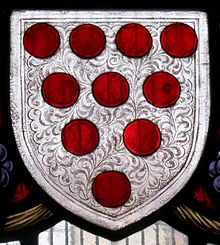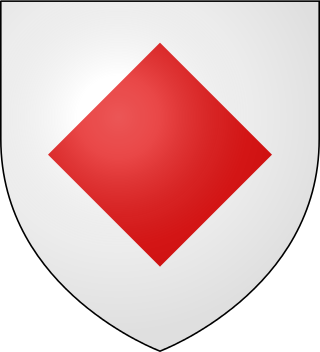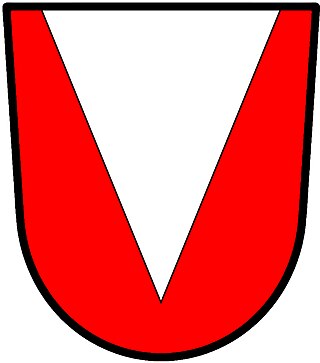

Diaper is any of a wide range of decorative patterns used in a variety of works of art, such as stained glass, heraldic shields, architecture, and silverwork. Its chief use is in the enlivening of plain surfaces.


Diaper is any of a wide range of decorative patterns used in a variety of works of art, such as stained glass, heraldic shields, architecture, and silverwork. Its chief use is in the enlivening of plain surfaces.
For the full etymology, see "diaper". The Oxford dictionary gives the Greek dia for "cross" as in "diamond" or "diagonal"; and aspros, Greek for "white". A white diamond or white cloth is used on the diagonal, hence the diagonal lattice or reticulation in patterning.

In architecture and other decorative arts, diaper is applied as a decorative treatment of a surface with a repeat pattern of squares (chequers), rectangles, or lozenges. Diaper was particularly used in medieval stained glass to increase the vividness of a coloured pane, for example the field in a shield of arms. [1] A stone wall may be decorated with such a pattern sculpted in relief; in brickwork the effect may be achieved by using bricks of different colours, or by allowing certain bricks to protrude from the wall's surface to create a regular diamond-shaped pattern. In English flushwork, limestone and dark knapped flint are used. Windows may be set in a diamond-shaped lattice. [2]
In Chinese carved lacquer, a convention developed by which the areas of sky, water and floor or ground that would be left largely blank in paintings are filled in with discreet patterns derived from textiles, known as "diaper backgrounds" and also "brocade-grounds" (錦地jǐndì, lit. ‘embroidery[-like] background’); this convention has continued to modern times. [3] They are also used on porcelains, especially borders.
Diaper in textiles refers to richly decorated fabrics with a small geometrical or floral pattern that consists of the constant repetition of one or more simple figures or units of design evenly spaced. The term was initially associated with silk with diamond patterns later applied to linen and cotton fabrics of similar designs. [4] [5]
In heraldry, diapering is a technique in which those who emblazon, draw, paint, or otherwise depict achievements of arms decorate large areas of flat colour by drawing crosshatches or arabesques. There is no standard, and each artist is allowed individual idiosyncrasies.
With very rare exceptions, diapering is not a part of the blazon, but is mere decoration, or ornamental accessory. Thus a shield with diapering is considered the same as a shield of the same design but without diapering. For this reason diapering must not be so obtrusive or so heavily drawn that it could be mistaken for a substantive charge or for a variation of the field. This is especially the case with diaper of simple cross-hatching which might be mistaken for a field of lozengy.
There are at least three Scots coats whose blazon includes diaper:

The coat of arms of Quebec was adopted by order-in-council of the Government of Quebec on 9 December 1939, replacing the arms assigned by royal warrant of Queen Victoria on 26 May 1868.

Tincture is the limited palette of colours and patterns used in heraldry. The need to define, depict, and correctly blazon the various tinctures is one of the most important aspects of heraldic art and design.

In heraldry, the field (background) of a shield can be divided into more than one area, or subdivision, of different tinctures, usually following the lines of one of the ordinaries and carrying its name. Shields may be divided this way for differencing or for purposes of marshalling, or simply for style. The lines that divide a shield may not always be straight, and there is a system of terminology for describing patterned lines, which is also shared with the heraldic ordinaries.

In heraldry, variations of the field are any of a number of ways that a field may be covered with a pattern, rather than a flat tincture or a simple division of the field.
Ordinaries in heraldry are sometimes embellished with stripes of colour alongside them, have lumps added to them, shown with their edges arciform instead of straight, have their peaks and tops chopped off, pushed up and down out of the usual positions, or even broken apart.

In heraldry, an ordinary is a one of the two main types of charges, beside the mobile charges. An ordinary is a simple geometrical figure, bounded by straight lines and running from side to side or top to bottom of the shield. There are also some geometric charges known as subordinaries, which have been given lesser status by some heraldic writers, though most have been in use as long as the traditional ordinaries. Diminutives of ordinaries and some subordinaries are charges of the same shape, though thinner. Most of the ordinaries are theoretically said to occupy one-third of the shield; but this is rarely observed in practice, except when the ordinary is the only charge.
In heraldry, sable is the tincture black, and belongs to the class of dark tinctures, called "colours". In engravings and line drawings, it is sometimes depicted as a region of crossed horizontal and vertical lines, or else marked with sa. as an abbreviation.

The lozenge in heraldry is a diamond-shaped rhombus charge, usually somewhat narrower than it is tall. It is to be distinguished in modern heraldry from the fusil, which is like the lozenge but narrower, though the distinction has not always been as fine and is not always observed even today. A mascle is a voided lozenge—that is, a lozenge with a lozenge-shaped hole in the middle—and the rarer rustre is a lozenge containing a circular hole in the centre. A field covered in a pattern of lozenges is described as lozengy; similar fields of mascles are masculy, and fusils, fusily. In civic heraldry, a lozenge sable is often used in coal-mining communities to represent a lump of coal.

The first coat of arms of Montreal was designed by Jacques Viger, the first mayor of Montreal, and adopted in 1833 by the city councillors. Modifications were made some one hundred five years later and adopted on 21 March 1938, and again on 13 September 2017, resulting in the version currently in use. The coat of arms was the only city emblem representing Montreal until 1981, when a stylized logo was developed for common daily use, reserving the coat of arms for ceremonial occasions.

The most basic rule of heraldic design is the rule of tincture: metal should not be put on metal, nor colour on colour. This means that the heraldic metals or and argent should not be placed on each other, nor may any of the colours be placed on another colour. Heraldic furs as well as "proper" are exempt from the rule of tincture.
Archbishop Tenison's School, commonly known as Tenison's, is a Church of England mixed secondary school located in the London Borough of Lambeth.

In heraldry, a bordure is a band of contrasting tincture forming a border around the edge of a shield, traditionally one-sixth as wide as the shield itself. It is sometimes reckoned as an ordinary and sometimes as a subordinary.

The Bishop of Hereford is the ordinary of the Church of England Diocese of Hereford in the Province of Canterbury.

In heraldry and heraldic vexillology, a blazon is a formal description of a coat of arms, flag or similar emblem, from which the reader can reconstruct the appropriate image. The verb to blazon means to create such a description. The visual depiction of a coat of arms or flag has traditionally had considerable latitude in design, but a verbal blazon specifies the essentially distinctive elements. A coat of arms or flag is therefore primarily defined not by a picture but rather by the wording of its blazon. Blazon is also the specialized language in which a blazon is written, and, as a verb, the act of writing such a description. Blazonry is the art, craft or practice of creating a blazon. The language employed in blazonry has its own vocabulary, grammar and syntax, which becomes essential for comprehension when blazoning a complex coat of arms.

In architecture, flushwork is decorative masonry work which combines on the same flat plane flint and ashlar stone. If the stone projects from a flat flint wall then the term is proudwork, as the stone stands "proud" rather than being "flush" with the wall.

In heraldry, a pile is a charge usually counted as one of the ordinaries. It consists of a wedge emerging from the upper edge of the shield and converging to a point near the base. If it touches the base, it is blazoned throughout.

A number of cross symbols were developed for the purpose of the emerging system of heraldry, which appeared in Western Europe in about 1200. This tradition is partly in the use of the Christian cross an emblem from the 11th century, and increasingly during the age of the Crusades. Many cross variants were developed in the classical tradition of heraldry during the late medieval and early modern periods. Heraldic crosses are inherited in modern iconographic traditions and are used in numerous national flags.

The coat of arms of Beverwijk is a coat of arms that has been renewed several times. The coat of arms of Beverwijk is the only coat of arms of a Dutch municipality that is surrounded by a cloak. This is highly unusual in the Netherlands, where such a cloak is normally reserved for nobility, the pope and national coats of arms.

The Coat of arms of the Prince of Spain was set out in the Spanish Decree 814 of 22 April 1971, by which the Rules for Flags, Standards, Guidons, Banners, and Badges were adopted.
Diaper was a damask cloth with small patterns, mostly geometrical such as bird' eye or diamond shaped. Different kind of diapers were referred to by special titles such as “bird’s-eye,” “pheasant’s-eye”; these terms denote the size of the diamond in the design of the cloth, the comparatively smaller pattern was named “bird’s-eye.” Diaper was used as a tablecloth.